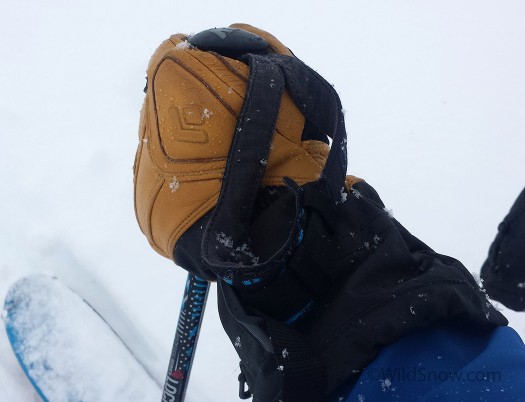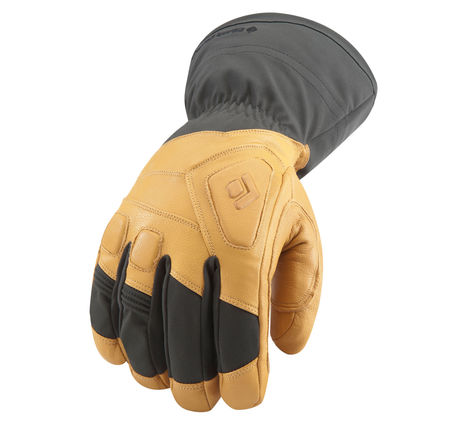Hands are difficult too keep warm and dry, especially in the damp environs of the North Cascades. I’ve seen and tried a slew of methods to combat the cold wet weather, everything from vinyl fishing gloves, various high-end ski gloves, and even training my hands with buckets of ice water.
There are tons of gloves out there and most “work” for backcountry skiing. They cover your hands and keep them fairly warm. However very few are exceptional…able to keep hands toasty and comfy in varied conditions.
Over the years of trying out and wearing out various gloves, I like to think I’ve found what works (at least for me). My needs:
They’ve got to be durable. Tattered gloves suck, and backcountry skiing is especially tough on gloves. Hanging on ski poles while trudging along a skin track wears on gloves, not to mention the plant wrangling that usually precedes the skin track in the PNWet. I’ve had several gloves that promised warm and dry hands, only to have gaping holes by the third or fourth tour.
Thick, quality leather, covering as much of the glove as possible, seems to be the only way to go. If this was the only requirement, $5 leather work gloves would be the ticket, but they lack a cavernous, weatherproof gauntlet. When the wind is howling or the pow is flying, sealing the glove-jacket interface is essential during backcountry skiing adventures.
Gloves have to be warm and weather-proof. Cold hands can be miserable and even dangerous. Besides losing dexterity, big, warm gloves have few disadvantages; the weight penalty is minimal.
Last on my list: Gloves that use sewn-in liners to achieve warmth and weather-resistance aren’t ideal. Invariably, every glove I’ve used that has a sewn-in liner becomes hopelessly tangled inside itself. Usually this happens at the worst moment. Attempting to jam a frozen digit through masses of fabric is one of the more frustrating backcountry experiences. A glove with a removable liner not only doesn’t have this problem, but it’s more versatile. You can use the liners or shells by themselves; you can separate the parts for quick drying.
So let’s see: a durable, leather glove, with a big gauntlet, tons of warmth, and a removable liner. The Black Diamond Guide gloves fit the bill perfectly. I’ve been using and abusing a pair since last winter.
BD Guide Gloves have a burly shell that’s almost entirely leather, except areas of stretch nylon, including the gauntlet. The removable inner liner is a combination of fleece and wool, with a thin nylon shell. The two parts are secured with Velcro. The glove is also sewn with Kevlar thread, a nice touch on the durability side of things. Surprisingly they aren’t the most waterproof gloves even though they do have a Gore-tex layer. (Perhaps hard use has overcome the Goretex, or having it in the liner is less resistant to soakage.) But since they are leather that is solved with liberal and frequent applications of Sno-seal. Other features include drawstrings that can be easily released and a soft snot-patch.
I initially got the gloves for my ski mountaineering trip to Alaska last year and used them in the cold, dry mountains of Glacier Bay. They worked beautifully. I usually carry a big pair of gloves, a pair of light gloves, and a burly set of mitts. The mitts stay buried in my pack 99% of the time, only used in severe cold and emergencies. Based on the temperature, I would sometimes leave the insulated liners in the tent, and just use my light gloves and the leather outer gloves.
Back in the Northwest, the gloves faced a tougher test. I used them through the last throes of winter, and then as backup gloves for spring ski touring. They of course are incredibly warm, perhaps a bit overkill, but it never hurts to have toasty hands. I was a bit skeptical of the water resistance, but they kept the H20 at bay, at least as well as other leather gloves out there.
Black Diamond pays attention to the fit and detail of the gloves and it shows. Having a well-contoured glove makes them surprisingly dexterous, even with the bulky insulation. After months of use, they show very little wear, consequence of having copious amounts of thick leather sewn with burly thread. The strength of the gloves makes them fairly heavy, perhaps their biggest drawback, especially when used as a backup pair in warmer weather.
With the weather outside, winter seems to be here, at least for now. I don’t mind it being a little early. I’m looking forward to proving the Guide Gloves’ durability, especially their resistance to high speed powder impacts.
Louie Dawson earned his Bachelor Degree in Industrial Design from Western Washington University in 2014. When he’s not skiing Mount Baker or somewhere equally as snowy, he’s thinking about new products to make ski mountaineering more fun and safe.


